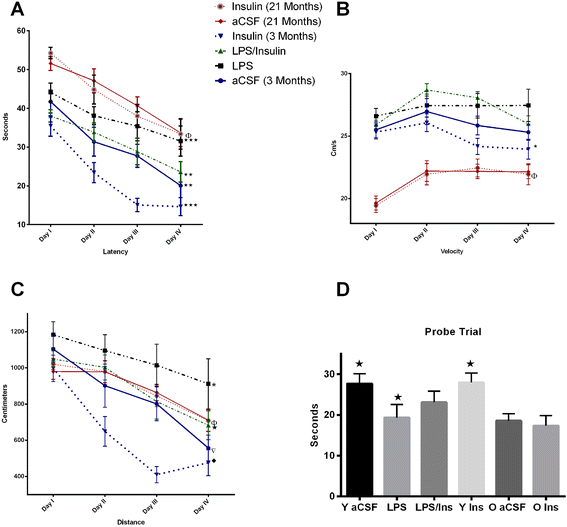Insulin improves memory and reduces chronic neuroinflammation in the hippocampus of young but not aged brains
- PMID: 25889938
- PMCID: PMC4391678
- DOI: 10.1186/s12974-015-0282-z
Insulin improves memory and reduces chronic neuroinflammation in the hippocampus of young but not aged brains
Erratum in
-
Erratum to: Insulin improves memory and reduces chronic neuroinflammation in the hippocampus of young but not aged brains.J Neuroinflammation. 2015 Aug 7;12:142. doi: 10.1186/s12974-015-0321-9. J Neuroinflammation. 2015. PMID: 26248591 Free PMC article. No abstract available.
Abstract
The role of insulin in the brain is still not completely understood. In the periphery, insulin can decrease inflammation induced by lipopolysaccharide (LPS); however, whether insulin can reduce inflammation within the brain is unknown. Experiments administrating intranasal insulin to young and aged adults have shown that insulin improves memory. In our animal model of chronic neuroinflammation, we administered insulin and/or LPS directly into the brain via the fourth ventricle for 4 weeks in young rats; we then analyzed their spatial memory and neuroinflammatory response. Additionally, we administered insulin or artificial cerebral spinal fluid (aCSF), in the same manner, to aged rats and then analyzed their spatial memory and neuroinflammatory response. Response to chronic neuroinflammation in young rats was analyzed in the presence or absence of insulin supplementation. Here, we show for the first time that insulin infused (i.c.v.) to young rats significantly attenuated the effects of LPS by decreasing the expression of neuroinflammatory markers in the hippocampus and by improving performance in the Morris water pool task. In young rats, insulin infusion alone significantly improved their performance as compared to all other groups. Unexpectedly, in aged rats, the responsiveness to insulin was completely absent, that is, spatial memory was still impaired suggesting that an age-dependent insulin resistance may contribute to the cognitive impairment observed in neurodegenerative diseases. Our data suggest a novel therapeutic effect of insulin on neuroinflammation in the young but not the aged brain.
Figures




References
Publication types
MeSH terms
Substances
Grants and funding
LinkOut - more resources
Full Text Sources
Other Literature Sources
Medical

